How Diamonds Are Polished
Suppose you were taking a walk somewhere in the middle of South Africa and, happening to glance down, saw at your feet a small, angular, irregular object, clear like glass but with a surface that looked as though it had been smeared with oil. You would probably kick it aside and proceed on your way; and yet this insignificant-looking thing might easily be a diamond of great value.
Diamonds as they are found in the rough state are not impressive. They have none of the magical flashes of light which in the finished stone make them unique among the noble family of gems. It is in polishing that a goodly part of the price of a diamond is acquired; for the art of turning a rough diamond into a glittering brilliant is a long process requiring a superlative degree of skill. There is no better way to appreciate this than to follow the diamond from the mine to the jeweler and see for ourselves just what happens to it.










 Home
Home